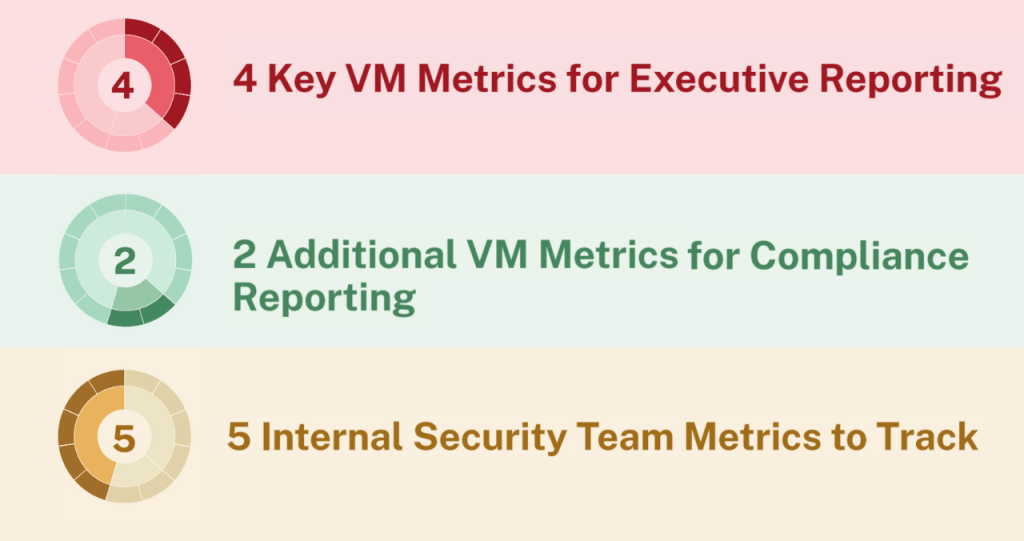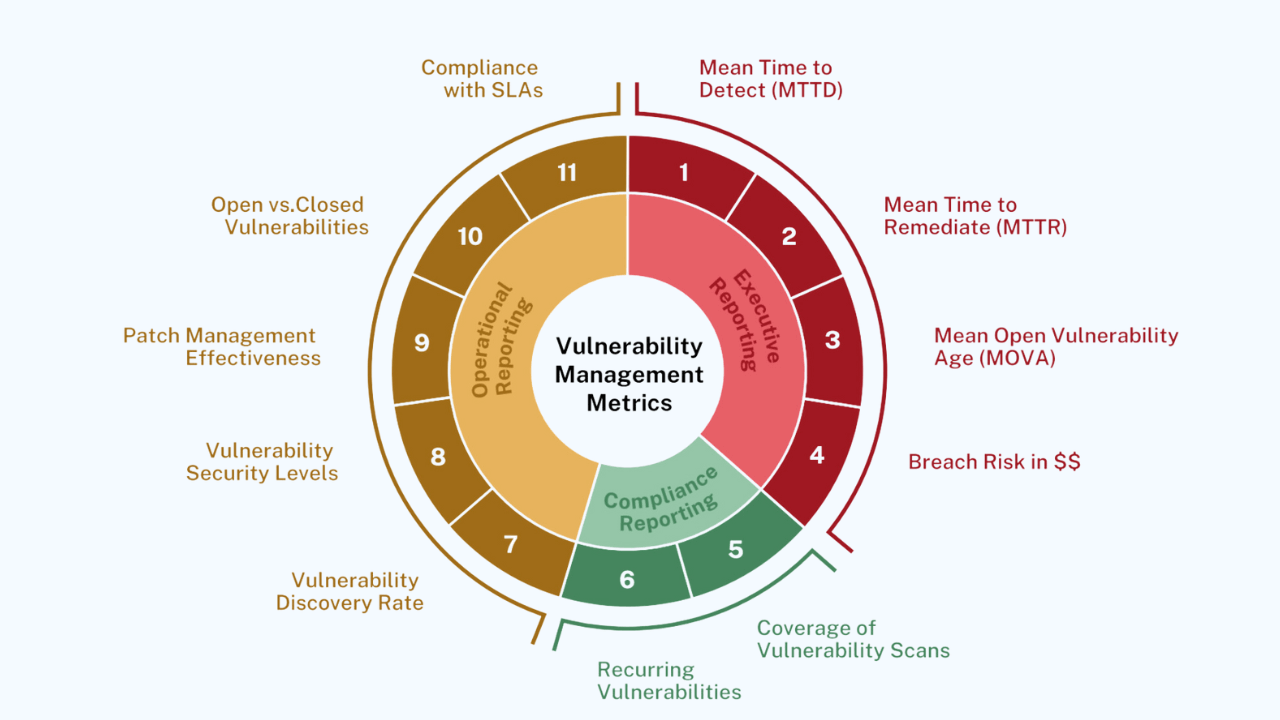Introduction
In our latest ebook, The Ultimate Guide to Vulnerability Management (VM) Metrics, we uncover the top 11 VM metrics you should measure and report, why these metrics matter to the success of your team and your business, and how to use them to get the executive buy-in, support and resources you need to maintain a successful VM program. Let’s highlight some of the key points in the ebook.
The Top 11 Vulnerability Management Metrics
The following 11 metrics are essential for tracking the success of your VM program:
- Mean Time to Detect (MTTD): MTTD measures the average time to identify vulnerabilities after initial discovery or reporting. Rapid detection is crucial for minimizing exposure and mitigating potential risks promptly. MTTD ensures organizations can respond swiftly to emerging threats.
- Mean Time to Remediate (MTTR): MTTR calculates the average time to remediate vulnerabilities after identification. It reflects the agility and effectiveness of the organization’s response to vulnerabilities, essential for reducing the window of opportunity for attackers.
- Mean Open Vulnerability Age (MOVA): MOVA tracks the age of open vulnerabilities, providing insights into the rate of incoming vulnerabilities and their resolution. This metric enables organizations to prioritize remediation efforts based on the urgency of vulnerabilities, minimizing their exposure to potential exploits.
- Breach Risk in $$: Leveraging Balbix’s Cyber Risk Quantification (CRQ), you can report the potential financial impact of a breach across the entire organization, assess the financial risk for each department or business unit, and track the reduction in financial risk over time
- Coverage of Vulnerability Scans: Assessing the percentage of organizational assets regularly scanned for vulnerabilities ensures comprehensive risk management. High coverage indicates proactive monitoring of the attack surface, reducing the likelihood of overlooking critical vulnerabilities.
- Recurring Vulnerabilities: Identifying and tracking the number of vulnerabilities that reappear after remediation highlights potential issues with patch management or security configurations. Addressing recurring vulnerabilities is crucial for maintaining a resilient security posture and preventing persistent threats.
- Vulnerability Discovery Rate: Tracking the rate of new vulnerabilities provides insights into the VM program’s responsiveness. It helps organizations stay proactive in identifying emerging threats and adapting their security measures accordingly.
- Vulnerability Severity Levels: Monitoring the severity classification of identified vulnerabilities allows for prioritized remediation efforts based on potential impact. However, it’s essential to complement severity scores with contextual factors such as asset criticality and threat intelligence feeds to assess the associated risks accurately.
- Patch Management Effectiveness: Assessing the success rate of patch deployments and timely remediation of vulnerabilities ensures proactive risk mitigation. Effective patch management is critical for addressing known vulnerabilities promptly and reducing the organization’s exposure to potential exploits.
- Open vs. Closed Vulnerabilities: The ratio of open vulnerabilities to resolved ones indicates progress in vulnerability management over time. It reflects the organization’s ability to address and remediate vulnerabilities effectively, reducing the overall risk posture.
- Compliance with SLAs: Monitoring compliance with cybersecurity SLAs ensures timely response to identified risks, reflecting the effectiveness of IT and security teams. High compliance rates indicate prompt vulnerability remediation, enhancing security posture and reducing the window of opportunity for exploitation. It also helps identify resource constraints, enabling proactive optimization of cybersecurity operations to mitigate risks effectively.
Why Do Vulnerability Management Metrics Matter?
These 11 metrics measure the core success criteria of your vulnerability management program including remediation efforts, patch effectiveness, improvements in risk awareness and reduction of potential financial impact of a breach.
Regularly monitoring your VM program ensures it is successful and regularly reviewed for any changes or improvements needing to be made based on the data presented in these metrics. These key vulnerability metrics also help to show program improvements over time in financial terms that boards and non-technical executive staff understand and highlight any milestones or achievements within the program.
How Should You Use These Metrics?
The above 11 metrics can be broken down into three categories:
- Executive Reporting Metrics: You should plan to present Mean Time to Detect (MTTD), Mean Time to Remediate (MTTR), Mean Open Vulnerability Age (MOVA), and Breach Risk in $$ to communicate overall program success in financial terms your executives understand.
- Compliance Reporting Metrics: In addition to the four metrics presented to the executives, you should regularly communicate Coverage of Vulnerability Scans and Recurring Vulnerabilities to management to facilitate VM program planning.
- Operational Reporting Metrics: The last five metrics are internal to the security team and should be tracked to continuously diagnose problem areas in your VM program. Those internal security team metrics include Vulnerability Discovery Rate, Vulnerability Severity Levels, Patch Management Effectiveness, Open vs. Closed Vulnerabilities and Compliance with SLAs.

How Balbix Helps Measure VM Metrics
Balbix is an AI-powered Cyber Risk Management platform that automates the ability to easily track and report the metrics above, enabling you to quantify and quickly reduce your cyber risk and report success to your board and executive staff. It provides visibility into your attack surface, quantifies your cyber risk in dollars and provides actionable next-best steps to efficiently mitigate risk.
Learn more about how Balbix help you optimize your VM program.


